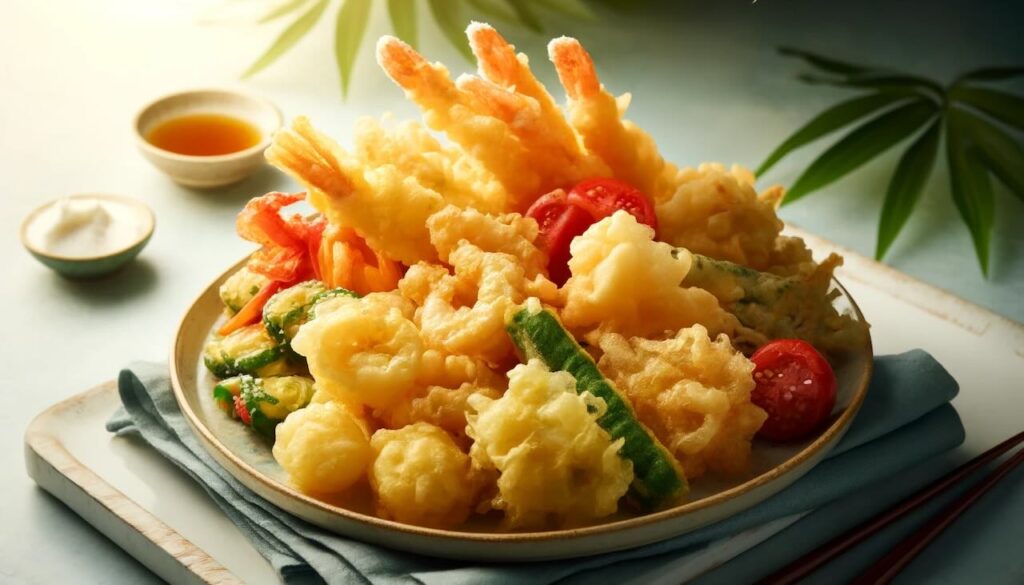Tempura is now one of Japan’s most iconic and beloved dishes — instantly recognizable for its delicate, crisp batter that highlights seasonal vegetables and seafood. Yet few realize that tempura’s origins are rooted in cultural exchange, adaptation, and centuries of refinement. Far from being purely indigenous, tempura reflects Japan’s unique ability to absorb foreign influences and transform them into something deeply Japanese.
In this article, we’ll trace the rich history of tempura, from its introduction to Japan to its evolution into a cornerstone of Japanese cuisine.
For a full guide to tempura’s ingredients, etiquette, and health aspects, visit:
👉 The Complete Guide to Tempura: Japan’s Artful Fried Delight
The Foreign Roots: Arrival of Portuguese Influence
Tempura’s journey into Japan likely began during the mid-16th century, when Portuguese missionaries and traders arrived in southern Japan, particularly in Nagasaki. They brought with them a dish called “peixinhos da horta” — vegetables dipped in batter and fried, similar to what would later become tempura.
The name “tempura” itself is widely believed to derive from the Latin word tempora, referring to Christian fasting periods when the consumption of meat was restricted. During these fasts, missionaries consumed seafood and vegetables — often fried — which caught the attention of Japanese cooks.
While frying was not entirely unknown in Japan prior to this (certain Heian-period dishes involved light flour coatings), the Portuguese frying technique introduced a new batter-based method that significantly influenced Japanese culinary development.
Tempura Takes Root: The Edo Period Transformation
It was during the Edo period (1603–1868) that tempura evolved into a uniquely Japanese culinary art.
Several factors fueled tempura’s rapid rise:
- The growth of Edo (modern Tokyo): The booming population of Edo fostered a vibrant street food culture where quick, flavorful, and portable foods thrived.
- Advances in oil production: Previously expensive, cooking oil became more widely available due to improvements in oil extraction methods, making deep-frying accessible to the masses.
- The rise of dashi culture: Edo’s growing appreciation for light, clean flavors matched perfectly with tempura’s ability to highlight the natural taste of ingredients.
Street stalls known as “yatai” served tempura as popular fast food alongside soba and sushi — quick, affordable, and deeply satisfying for Edo’s merchants and townspeople.
To explore more about tempura’s ingredient diversity, visit:
👉 The Essential Ingredients of Tempura: From Tradition to Creative Variations
Regional Variations and Sophistication
As tempura spread beyond Edo, various regional styles emerged:
- Kyoto (Kyo-tempura): Known for its refined, lighter style reflecting the elegance of Kyoto’s imperial culinary traditions.
- Nagasaki (Deage): Influenced directly by Portuguese contact, featuring local seafood fried in unique batters.
- Osaka and Kansai: Often incorporates seasonal vegetables and emphasizes the harmony between tempura and accompanying dishes like udon or soba.
This regional diversity reflects how Japanese cuisine as a whole prioritizes seasonality (shun) and local character.
Modern Tempura: From Street Food to Fine Dining
Today, tempura enjoys a dual identity:
- Everyday comfort food: Found in casual restaurants, tempura rice bowls (tendon), and home kitchens.
- High-end culinary art: Dedicated tempura-ya restaurants serve tempura one piece at a time, carefully controlling oil temperature, timing, and ingredient freshness to achieve absolute perfection.
In both settings, the guiding principle remains the same: respect for the ingredient’s natural flavor, enhanced — not hidden — by the delicate batter.
To better understand how to fully enjoy tempura, explore:
👉 Mastering the Art of Eating Tempura: Etiquette and Tips for Enjoying Japan’s Favorite Fried Dish
Tempura as a Symbol of Japanese Adaptability
Tempura’s evolution beautifully illustrates a core characteristic of Japanese culture: the ability to adopt foreign influences while transforming them into something distinctively Japanese.
What began as a European-inspired cooking technique became seamlessly integrated into Japan’s cuisine of refinement and restraint, emphasizing craftsmanship, seasonality, and aesthetic balance.
Even in modern times, tempura continues to evolve — from creative variations like tempura burgers or fusion dishes to new interpretations by Michelin-starred chefs — while always maintaining its cultural roots.
For insights on tempura’s nutritional aspects, visit:
👉 The Health Impact of Tempura: Enjoying It Wisely
Conclusion
The history of tempura is not merely a culinary story — it’s a testament to Japan’s remarkable cultural adaptability and enduring respect for nature’s flavors. From Portuguese missionaries to Edo street stalls to modern fine dining, tempura has become one of Japan’s most treasured culinary arts.
Its simple appearance hides a complex cultural legacy that continues to captivate diners around the world — one perfectly crisp bite at a time.


